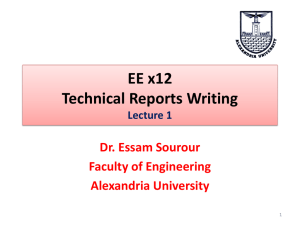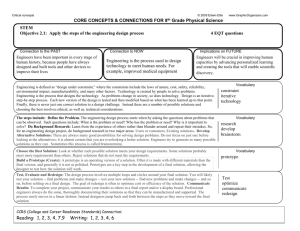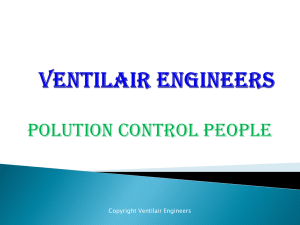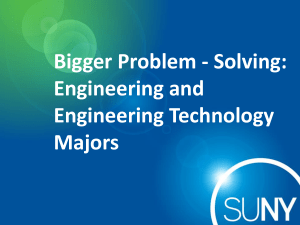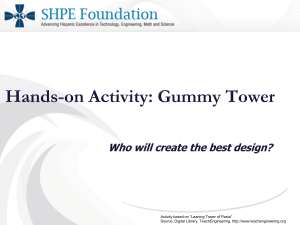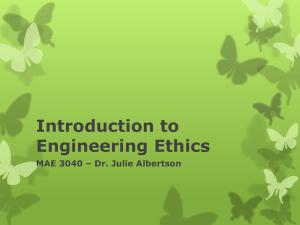here - University of Pittsburgh
advertisement
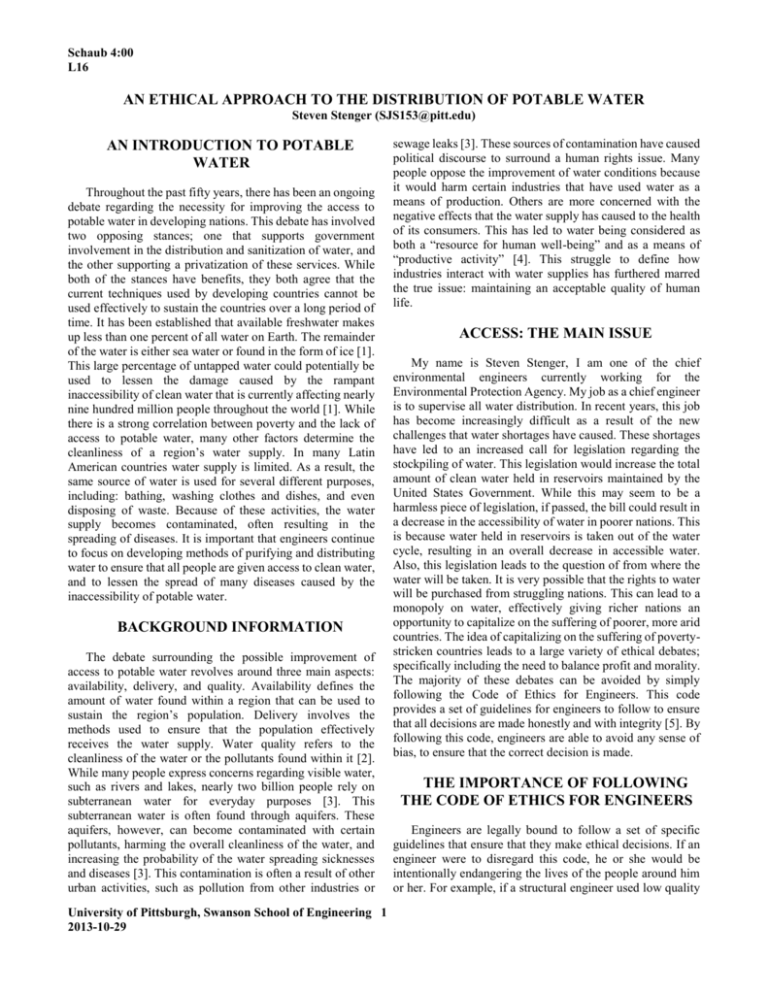
Schaub 4:00 L16 AN ETHICAL APPROACH TO THE DISTRIBUTION OF POTABLE WATER Steven Stenger (SJS153@pitt.edu) AN INTRODUCTION TO POTABLE WATER Throughout the past fifty years, there has been an ongoing debate regarding the necessity for improving the access to potable water in developing nations. This debate has involved two opposing stances; one that supports government involvement in the distribution and sanitization of water, and the other supporting a privatization of these services. While both of the stances have benefits, they both agree that the current techniques used by developing countries cannot be used effectively to sustain the countries over a long period of time. It has been established that available freshwater makes up less than one percent of all water on Earth. The remainder of the water is either sea water or found in the form of ice [1]. This large percentage of untapped water could potentially be used to lessen the damage caused by the rampant inaccessibility of clean water that is currently affecting nearly nine hundred million people throughout the world [1]. While there is a strong correlation between poverty and the lack of access to potable water, many other factors determine the cleanliness of a region’s water supply. In many Latin American countries water supply is limited. As a result, the same source of water is used for several different purposes, including: bathing, washing clothes and dishes, and even disposing of waste. Because of these activities, the water supply becomes contaminated, often resulting in the spreading of diseases. It is important that engineers continue to focus on developing methods of purifying and distributing water to ensure that all people are given access to clean water, and to lessen the spread of many diseases caused by the inaccessibility of potable water. BACKGROUND INFORMATION The debate surrounding the possible improvement of access to potable water revolves around three main aspects: availability, delivery, and quality. Availability defines the amount of water found within a region that can be used to sustain the region’s population. Delivery involves the methods used to ensure that the population effectively receives the water supply. Water quality refers to the cleanliness of the water or the pollutants found within it [2]. While many people express concerns regarding visible water, such as rivers and lakes, nearly two billion people rely on subterranean water for everyday purposes [3]. This subterranean water is often found through aquifers. These aquifers, however, can become contaminated with certain pollutants, harming the overall cleanliness of the water, and increasing the probability of the water spreading sicknesses and diseases [3]. This contamination is often a result of other urban activities, such as pollution from other industries or University of Pittsburgh, Swanson School of Engineering 1 2013-10-29 sewage leaks [3]. These sources of contamination have caused political discourse to surround a human rights issue. Many people oppose the improvement of water conditions because it would harm certain industries that have used water as a means of production. Others are more concerned with the negative effects that the water supply has caused to the health of its consumers. This has led to water being considered as both a “resource for human well-being” and as a means of “productive activity” [4]. This struggle to define how industries interact with water supplies has furthered marred the true issue: maintaining an acceptable quality of human life. ACCESS: THE MAIN ISSUE My name is Steven Stenger, I am one of the chief environmental engineers currently working for the Environmental Protection Agency. My job as a chief engineer is to supervise all water distribution. In recent years, this job has become increasingly difficult as a result of the new challenges that water shortages have caused. These shortages have led to an increased call for legislation regarding the stockpiling of water. This legislation would increase the total amount of clean water held in reservoirs maintained by the United States Government. While this may seem to be a harmless piece of legislation, if passed, the bill could result in a decrease in the accessibility of water in poorer nations. This is because water held in reservoirs is taken out of the water cycle, resulting in an overall decrease in accessible water. Also, this legislation leads to the question of from where the water will be taken. It is very possible that the rights to water will be purchased from struggling nations. This can lead to a monopoly on water, effectively giving richer nations an opportunity to capitalize on the suffering of poorer, more arid countries. The idea of capitalizing on the suffering of povertystricken countries leads to a large variety of ethical debates; specifically including the need to balance profit and morality. The majority of these debates can be avoided by simply following the Code of Ethics for Engineers. This code provides a set of guidelines for engineers to follow to ensure that all decisions are made honestly and with integrity [5]. By following this code, engineers are able to avoid any sense of bias, to ensure that the correct decision is made. THE IMPORTANCE OF FOLLOWING THE CODE OF ETHICS FOR ENGINEERS Engineers are legally bound to follow a set of specific guidelines that ensure that they make ethical decisions. If an engineer were to disregard this code, he or she would be intentionally endangering the lives of the people around him or her. For example, if a structural engineer used low quality Steven Stenger materials to build a bridge, that engineer would be endangering civilians in order to save money. Not only is this a violation of the Code of Ethics for Engineers, it is also a violation of civil law. Environmental engineers are obligated to follow the same set of values. The first point of this code states that “engineers shall hold paramount the safety, health, and welfare of the public” [5]. This is a point that directly effects the decisions made by many engineers. Engineers are also made to abide by the idea of “[striving] to comply with the principles of sustainable development in the performance of their professional duties” [6]. When this statement is considered during a decision-making process, engineers must take into account the impact that their choices will have on future generations. Engineers are entrusted to improve the lives of future generations by making ethical decisions that also improve the lives of members of the current generation. This is further evinced in the canon that states that engineers must “act for each employer or client as faithful agents or trustees” [5]. In the case of water distribution, the needs of the clients, the people in need of water, must come before the desires of the employer. share of the profits from water sales. While this may seem to be beneficial, it causes a monopoly on water. This would allow for the government to create their own prices. Without competition, prices of water could skyrocket, further increasing the large percentage of income that many people spend on water. Many cities struggling to provide water to their inhabitants tap into groundwater to fulfill the water demands. This is accomplished through either wells or boreholes, providing individuals with a seemingly reliable method of extracting water. However, this method comes with a high risk of contamination. According to the Environmental Protection Agency, groundwater can be contaminated through a variety of different sources, including improper disposal of wastes, leaks and spills at treatment plants, and saline intrusions [5]. Although all of these sources of contamination can be eliminated as new techniques for treating water are developed, it is more important for cities to develop techniques that will contribute to a more sustainable supply of water. This, however, can only be done through additional funding. While increasing the amount of water held in American reservoirs could positively impact the American people, a drastic increase in reservoir supply would have an impact on many countries around the world. This legislation would also set an example of legislation based solely on selfpreservation. If other countries were to follow this example, poorer nations would have to compete to gain access to the little amount of potable water that remains. As stated previously, the vast majority of water on earth is either impure or inaccessible. As a result, methods of extraction and purification would have to be improved in order to grant poorer nations access to this water. These improvements, however, would require funding that most poor countries cannot afford. Because of this, access to this water would require the intervention of a more financially stable country. This situation does not often arise without any outside influences because of the modern image of relationships between countries. However, a change in this common preconceived image would allow for an increase in international unity throughout the globe. ETHICAL DILEMAS SURROUNDING POTABLE WATER The limited access to potable water in many cities throughout the world works as the primary obstacle to the poor. This is largely due to the fact that the poor are forced to seek alternative means of acquiring water. Wealthier residents of areas with a limited water supply can afford to buy water through a private party, and often receive the water at a discounted price. For example, many people living in wealthier neighborhoods in Mexico receive around one thousand liters of water at the total cost of $40. Residents of poorer neighborhoods spend up to $1100 for two hundred liters of water [7]. As a result, it is clear that the allocation of resources depends strongly on the social standing of the consumers. This was further reinforced by recent protests in Nicaragua that advocated for a change in the policies surrounding the privatization of water [8]. Because of this, it is clear that certain legislation must be passed in certain regions to ensure access to clean water. However, this type of legislation is not required in areas that have an ample supply of clean water. The passing of this type of legislation by countries with a sufficient water supply would cause regions with a scarce water supply to suffer further. The scarcity of water in certain, arid countries has resulted in a high amount of private water distributors. While these private parties often overcharge their customers, contributing to the poverty that already plagues many of these countries, competition between private companies ensures that prices do not become too high. It has been shown that the poor could be spending up to 20% of their income on water [2]. However, an increase in government owned water would result in a decrease in private sellers, giving the government a greater POSSIBLE SOLUTION Instead of stockpiling water in preparation of water shortages, legislation should be put in place to limit the amount of water used in a non-essential manner. For example, in Arizona, citizens must file a permit for withdrawing a large amount of water. Once a permit is issued, the person can withdraw a specific amount of water, from a specific location, for a specified purpose [9]. This form of saving water should be applied on a national scale to ensure that water distribution is not hindered. Water will be conserved instead of confined to a specific region. This will contribute to the “huge volumes of additional freshwater […] required to produce the food needed to eradicate hunger” [10]. This would also help to 2 Steven Stenger [3] M. Valente. (2010). “SOUTH AMERICA: Clear Water – Mercosur’s Underground Treasure.” Inter Press Service. (Online article). http://www.ipsnews.net/2010/04/south-america-clear-watermercosurs-underground-treasure/ [4] B. Orlove, S.C. Caton. (2010). “Water Sustainability: Anthropological Approaches and Prospects.” Annual Review of Anthropology. (Online article). http://www.annualreviews.org/doi/abs/10.1146/annurev.anth ro.012809.105045 [5] “Code of Ethics for Engineers.” National Society of Professional Engineers. (2007). (Online article). http://www.nspe.org/resources/pdfs/Ethics/CodeofEthics/Co de-2007-July.pdf [6] “Code of Ethics.” American Society of Civil Engineers. (2006). (Online Article). http://www.asce.org/Ethics/Codeof-Ethics/ [7] M.C. Ennis-McMillan. (2001). “Suffering from Water: Social Origins of Bodily Distress in a Mexican Community.” Medical Anthropology Quarterly. (Online article). http://onlinelibrary.wiley.com/doi/10.1525/maq.2001.15.3.3 68/pdf [8] S.T. Romano. (2012). “From Protest to Proposal: The Contentious Politics of the Nicaraguan Anti-Water Privitisation Social Movement.” Bulletin of Latin American Research. (Online article). http://onlinelibrary.wiley.com/doi/10.1111/j.14709856.2012.00700.x/full [9] “State Water Withdrawal Regulations.” National Conference of State Legislatures. (2013). (Online Article). http://www.ncsl.org/research/environment-and-naturalresources/state-water-withdrawal-regulations.aspx [10] Johan Rockström, Mats Lannerstad, Malin Falkenmark. (2007). “Assessing the Water Challenge of a New Green Revolution in Developing Countries.” Proceedings of the National Academy of Sciences of the United States of America. (Online Article). http://www.jstor.org/stable/25427364 [11] Ronald C. Griffin, James W. Mjelde. (2000). “Valuing Water Supply Reliability.” American Journal of Agricultural Economics. (Online Article). http://www.jstor.org/stable/1244661 conserve water especially during summer months, when water supply is low and usage is high [11]. In order to ensure that this form of legislation is favored over the stockpiling legislation, I plan to propose this solution to the Administrator of the Environmental Protection Agency. I personally believe that an ulterior form of legislation would result in more global harm than positive national factors. Enlarging a municipal supply of water, effectively forming a monopoly on water, would result in more problems in the future. Cutting down on non-essential water would allow for the water supply to be drained at a slower pace. As a result, the effectiveness of a region’s water supply would greatly increase. This would result in a change in the manner in which the resource of water is viewed. It would no longer be considered a national resource, it would become a global commodity. This is because, when water is used efficiently, there is a lesser need for a large supply. Saving water in one area of the world results in a more well-rounded distribution of clean water. CONCLUSION: LOOKING TOWARDS TOMORROW The primary goal for all engineers should be to ensure that all people are granted access to commodities that are necessary for the sustenance of life. Clean water is among these basic resources. As stated previously, a large portion of the world’s population goes without this resource, contributing to the spread of diseases, a lack of hygiene, and thirst [6]. Within the next twenty years, these percentages will increase, resulting in an even more imbalanced distribution of water. However, if this subject receives a continued focus, I firmly believe that engineers can help to lessen the strain caused by the inaccessibility of potable water. This can specifically be accomplished through the improvement of extraction and purification methods. However, if these methods remain unimproved, new forms of conserving water will help to prevent the complete depletion of a country’s water supply. With this in mind, the EPA, and all engineers in general, should change their focus from a stockpile mentality to a more focused mentality surrounding the idea of making the current water supply last for a more extended period of time. ACKNOWLEDGEMENTS REFERENCES I would like to thank Jordan Klette-Cusher and Nate Burwell for taking the time to proofread and edit my paper. I would also like to thank my resident advisor, Drew Gordish, for offering guidance during this writing process. [1] J. Wade. (2012). “The Future of Urban Water Services in Latin America.” Bulletin of Latin American Research. (Online article). http://onlinelibrary.wiley.com/doi/10.1111/j.14709856.2011.00603.x/full [2] R. McDonald, I. Douglas, C. Revenga, et al. (2011). “Global Urban Growth and the Geography of Water Availability, Quality, and Delivery.” Ambio. (Online article.) http://link.springer.com/article/10.1007%2Fs13280-0110152-6/fulltext.html 3 Steven Stenger 4



